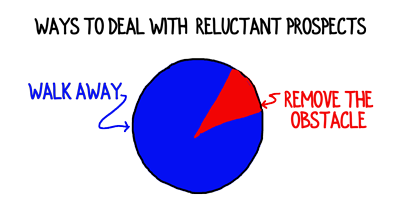You were introduced to Steve Jones, CEO of Midgrowth Co. and through some tactful probing, you realized he needs your help. Midgrowth has the problem you solve. Steve even admitted the situation should be addressed (after a few of your pointed questions made it hard to deny).

You then diligently walked Steve through the Context Discussion, understanding his concerns and determining (albeit without much help from Steve) the value that solving the problem will have for Steve and Midsize. After a bit of discussion you agreed to submit a proposal by Monday and you locked in Tuesday at [10:00] for the follow up conversation.
The proposed fees ranged from $59k to $110k and Tuesday morning you could taste the six-figure win. Ten o’clock rolled around and Steve didn’t answer your call. He didn’t pick up at [10:30] either. Nor on Wednesday, Friday, the following Monday or two weeks later. Since you’re a whip-smart consultant you realize Steve is a bit reluctant to hire you. Now what?
Ah, the case of the reluctant prospect. Happens to every consultant. It happens a lot to some consultants and I bet you want to know how to win those projects. I’ll give you two (and a half) alternatives and a diagnostic to determine which to choose.
Alternative 1: Walk away.
Alternative 2: Remove the obstacle.

Most of the time you should walk away.
Seriously. You want to be a successful, wealthy consultant and the secret to being successful is choosing the right clients! Who are the right clients? Those who want to work with you. Those who have a burning desire to solve a problem or achieve an aspiration and are eager to enlist you in their effort.
Projects with reluctant clients very rarely deliver wildly successful outcomes, and commonly morph into frustrating, disappointing endeavors that put your reputation at risk.
Steve was giving you plenty of clues about his level of (dis)interest during the discovery process. Let’s look at the interest/passion level of a prospect over time.

In the first graph, Steve has moderate interest in addressing the problem, but not enough to hire you.
Now let’s look at what happens when you start talking with Steve.

While you’re engaged with Steve, his interest increases. For a short time.
There is absolutely no doubt that the more passionate and excited you are about the opportunity, the more energy Steve will have. Passion is contagious.
So, walk away. At least emotionally. You can still send the occasional email, but assume it’s a no-go.
Don’t push. If you frequently encounter reluctant prospects you’re spending too much time pushing for projects, selling yourself and asking for business. Remember: consulting projects are bought, not sold.
Alternative #2 is to remove the obstacle.
This is appropriate when Steve’s interest and desire are high but something else is preventing him from moving forward. Maybe it’s a policy issue, timing, a competitive move, or a larder bare of action-inducing chocolate.
Then you collaborate with Steve to work around the obstacle—conform to the policy, adjust the timing, adapt to the competition, send chocolate—if at all possible. Sometimes it’s not possible to remove the obstacle, in which case you… walk away.
Okay, but how do you diagnose whether you’re facing borrowed passion or a real obstacle?
You ask.
You send an email and/or leave a phone message with this simple, compound question:
“Steve, what’s getting in the way of us moving forward? I’d really appreciate your candid response so I can close the loop on our discussions. Is it a lack of priority or interest, or are you not seeing the value or is there something else in the way?”
At least 80% of the time Steve will respond. Unfortunately, most of those responses can be interpreted as your project being low priority. In other words, you were reacting to borrowed interest. Walk away.
However, there will be instances in which Steve apologizes for his tardiness and reveals the obstacle. Cool. Jump into obstacle-removal mode.

There are also rare instances in which Steve has a passion for the project and hasn’t jumped into it yet, but doesn’t see your value or doesn’t believe/trust you’ll deliver the desired outcome.
In those cases you turn to Alternative 2.5: Ask whether he’s open to discussing his concerns. Perhaps you can sway him during further conversations.
Those cases are rare, though, because if Steve had passion for the project and two weeks or more have passed, chances are he’s already found an alternative source of help—internal or external.
Alternative #3.
Hey, I said there were 2.5 alternatives… where did Alternative #3 come from? Surprise. The third alternative is to not have a reluctant prospect in the first place; it’s to spark a native passion to work with you.

These are the clients you want. They have some interest, then you plant a seed which they nourish and cultivate until they can’t wait to bring you in. Their passion is native, not borrowed. Those projects succeed and boost your reputation.
]
You provoke native desire during the discovery process by tapping into the emotional drivers behind the project. If they exist. You can’t manufacture these; you can only brush the ashes off the ember of desire then fan it into flame.
The key is to leave your prospect with an incomplete vision of the future. If you paint the entire future, their interest will fade when you leave. Conversely, if you force them to fill in the picture, then they start to dream, to hope, to crave… and to want you to help them achieve the vision.
I’ve created a handy “How to Deal with Reluctant Clients” flow chart, which you can see by clicking on the image below.
How have you dealt with reluctant clients? Have you walked away? Have you overcome their reluctance? I’d like to hear.
Text and images are © 2024 David A. Fields, all rights reserved.

 David A. Fields Consulting Group
David A. Fields Consulting Group 


I’ve got a bank on this position. When I met in person they were super excited, just as they were in subsequent meetings. Then the proposal.
They said, “we’re super busy, don’t be alarmed if we don’t get back to you for awhile”. Phone calls and emails not returned.
I’ll drip on them occasionally but have walked away emotionally.
Nice example, Scott, though I’m sure it’s frustrating. “We’re super busy” is another way of saying, “You’re not a high priority.” Fair enough. Time to move on. Good for you for keeping them on the prospect list while focusing on other opportunities. That is, by far, the best way to land more business.
I think it is useful to probe their direct and corporate experience with consultants. Sometimes after the passion ebbs, they ask how it will look to the organization if they hire a consultant.
Charles, that’s a very good point. One of the ways you can address that early on is by asking what concerns the prospect has about bringing in a consultant. Fortunately, that question is part of the Context Discussion and if you’re diligent about following the process, you can deal with that issue head on. I appreciate you highlighting this piece of the puzzle.
Always excellent direction David. Thank you! Looking back over previous clients and my current prospect list, it feels like those who hold their own on the passion side of this equation and value my contribution to their vision are always most rewarding in every sense of the word. These also tend to be the clients I ‘click’ with best, come back to working with again and enjoy strong reciprocal relationships with. Your advice will be ringing in my ears as I walk peacefully from any clients that don’t fit.
“Walking peacefully from clients that don’t fit.” What a lovely phrase, Joy! And isn’t it amazing to fill your day with clients who value you and are excited to work with you? That’s the world we all can live in if we’re willing to peacefully walk away. Thank you for sharing your experience, Joy. Much appreciated.
This was a very timely posting for me–I had a prospective client say yes to me a few weeks ago and then went radio silent, so I was a bit perplexed what was going on. Emails and a phone call were not returned. So, I sent an email that used your language and I got a response back in about 5 minutes apologizing and that she does want to start but that she was confused about the timeline. Anyway, I’ll get there with this client, so thank you again!
Wow, Howard, that’s quite the illustration. There’s little more befuddling than a prospect who says “Yes” then disappears. (Except once I had a client who signed, paid me, then disappeared.) You’ve provided a great confirmation that the language works and can shake loose a project that mysteriously disappeared.